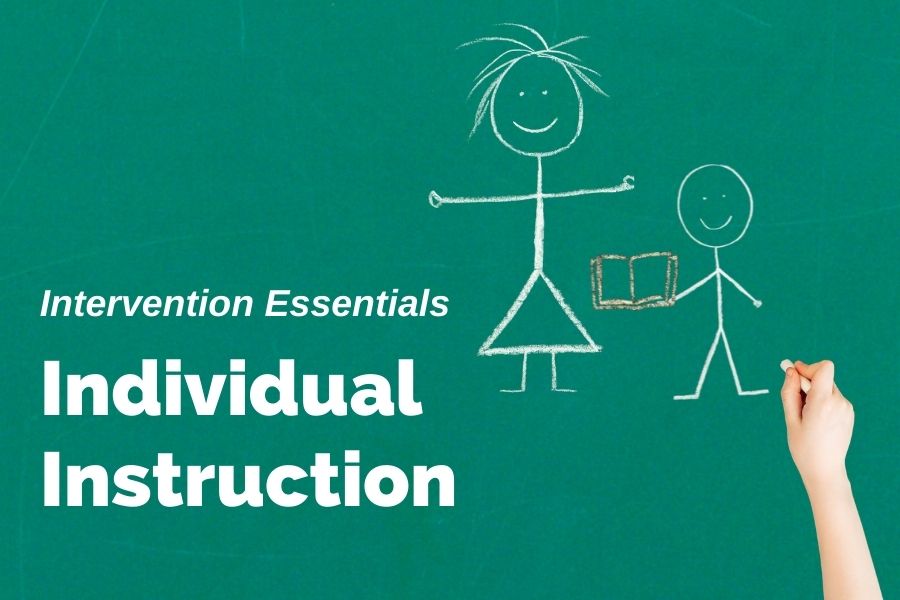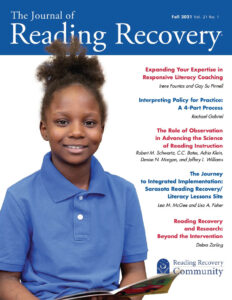BLOG
Intervention Essentials #2: Importance of Individual Instruction
by Annie Opat, Emporia State University
Why are Reading Recovery® lessons taught one-to-one?
Reading Recovery teachers are responsible for instructing first-grade children who are the lowest achievers in beginning reading and writing, “[c]hildren who will learn to read and write only if they get individual attention” (Clay, 2016, p. 15). The achievement levels and instructional needs of these students are confirmed by observation and formal assessment in An Observation Survey of Early Achievement (Clay, 2019). The Reading Recovery teacher’s mandate is to provide instruction allowing these students to accelerate their learning and demonstrate the literacy proficiency expected of the average learners in their grade cohort within 12–20 weeks of the intervention.
Reading Recovery teachers are successful in this effort with significant numbers of students, and this success is verified annually by analyses of national data reported by the International Data Evaluation Center (see Mauck & Brymer-Bashore, 2021). Significant, positive treatment results have also been revealed by external evaluations (May et al., 2016) and in summaries of the research of multiple literacy programs as detailed by Allington (2013):
“Of the 153 different reading programs reviewed by the WWC (What Works Clearinghouse), only one had ‘strong evidence’ that it improved reading achievement! One! That program was Reading Recovery.” (p. 522)
Key to this success is Marie Clay’s design for Reading Recovery lessons to be taught one-to-one.
Why Individual Instruction?
Literacy acquisition is a complex, problem-solving process. Although approximately 80% of young children learn reading and writing through various methods of instruction in group settings (Clay, 2016), Reading Recovery children are those unable to make progress within the context of group instruction; the written code remains a mystery. This is because small-group instruction does not permit the classroom teacher to attend closely to each student’s performance and responses. Instructional compromises are made as the teacher selects materials, identifies learning objectives, and presents lessons for the group that may not meet the needs of individuals (Clay, 2016). For the confused student, this may result in the development of inappropriate, unhelpful ways of responding to reading and writing tasks and their achievement then wanes, resulting in widening the achievement gap. Young students who experience the most difficulty acquiring beginning literacy require and deserve individual, expert attention to positively change their literacy learning trajectories.
Additionally, while all Reading Recovery children are the lowest performing in their grade cohort, no two learners are the same. Reading Recovery selection is inclusive, and there are no exceptions to access to the intervention based on intelligence, oral language skills, first language, immaturity, learning disabilities, poor motor skills, economic factors, or prior experiences. None of these factors predict their literacy learning success if provided adequate instruction. Moreover, what is difficult in learning to read and write differs from child to child (Clay, 2016). The resulting diversity among Reading Recovery students is addressed effectively in one-to-one settings with expert, observant teachers. The one-to- one instructional setting allows the Reading Recovery teacher to design lessons tailored to the specific strengths and needs of each individual learner. As a result, Reading Recovery teachers are successful in lifting the literacy achievement of the diverse set of learners they serve (Clay, 2016).
What are the Benefits of Individual Instruction?
Two key goals of the Reading Recovery intervention are acceleration of each student’s literacy learning and identification of those students in need of ongoing specialist support. Individual instruction is essential to realizing these goals.
Time is critical to prevent further literacy confusion and to stop widening the achievement discrepancy between struggling learners and average literacy learners. Each daily lesson provides exactly what is needed for the learner to acquire reading and writing knowledge. Based on careful observation of the individual student’s reading and writing behaviors and patterns, the Reading Recovery teacher provides contingent, responsive instruction during each intensive lesson. “Observant teachers not only discover new behaviors and changes in behaviors but also think about children’s learning in new ways” (Clay, 2014, p. 100). The teacher “designs each part of every lesson and wastes no time teaching what the learner already knows. This is a critical variable for Reading Recovery’s success” (Clay, 2016, p. 18). Likewise, there is no set sequence of curricular goals that the teacher and child must follow; each learner is supported in creating a unique path to literacy.
Expert instruction allows the learner to take over the learning process, make new discoveries independently, and make progress in both reading and writing at an accelerated rate. This learner acceleration allows the student to achieve grade-level proficiencies in reading and writing within a short timeframe, e.g., 12 to 20 weeks.
Students who accelerate reach grade-level proficiencies that allow them to continue learning within the context of their classroom programs, often without ongoing ancillary help beyond the support of their classroom teachers. Thus, both referrals to special services, including special education, and the retention of children in first grade are reduced. The savings realized by the school in the reductions of referrals to special education, limited needs for remedial services, and fewer retentions are a substantial benefit making one-to-one instruction economically beneficial (Reading Recovery Council of North America, 2021).
While almost all Reading Recovery children make progress, a few students do not develop the independence and literacy processing systems required to ensure ongoing progress without additional support. These students are referred for ongoing specialist evaluation and instructional intervention. The early identification of students deserving of specialist help is another positive outcome of Reading Recovery. For these students, records of their one-to-one lessons provide rich diagnostic information beneficial for describing their literacy behaviors and determining appropriate instructional recommendations.
Summary
Reading Recovery teachers make a positive difference in the lives of children, one by one. As Marie Clay (2016) has so eloquently stated: “[I]nstruction that is individually designed and individually delivered provides the intensive care that results in the fastest recovery of a normal trajectory of progress for any child” (p. 19).
“Intervention Essentials” is a three-part series featured in the Fall 2021 edition of The Journal of Reading Recovery. View and print a copy of Part 2: Importance of Individual Instruction and subscribe to the blog for future releases.
Interested in full access to The Journal of Reading Recovery? Learn more about becoming a member of RRCNA.
References
Allington, R. L. (2013). What really matters when working with struggling readers. The Reading Teacher, 66(7), 520– 530.
Clay, M. M. (2014). By different paths to common outcomes: Literacy learning and teaching. Global Educational Systems (GES) Ltd.
Clay, M. M. (2016). Literacy lessons designed for individuals (2nd ed.). Global Education Systems (GES) Ltd.
Clay, M. M. (2019). An observation survey of early literacy achievement (4th ed.). Global Education Systems (GES) Ltd.
Mauck, S. A.,& Brymer-Bashore, J. B. (2021). A report of national outcomes for Reading Recovery and Descubriendo la Lectura for the 2019–2020 school year. The Journal of Reading Recovery, 20(2), 61–71.
May, H., Sirinides, P., Gray, A., & Goldsworthy, H. (2016). Reading Recovery: An evaluation of the four-year i3 scale-up. Consortium for Policy Research in Education. http://www. cpre.org/reading-recovery-evaluationfour- year-i3-scale
Reading Recovery Council of North America. (2021). A site coordinator’s guide to the effective implementation of Reading Recovery (2nd ed).
Dr. Annie Opat is a professor and trainer/director of Reading Recovery at Emporia State University in Kansas.
THE JOURNAL OF READING RECOVERY
Spring 2025
OPEN ACCESS: Centering Children and Working Towards Equity: Teaching All Children to Read by Catherine Compton-Lilly
Literacy Leadership in Support of Equity: Whatever It Takes by Allison Briceño
Exploring the Purposes, Power, and Potential of Familiar Reading by Jamie Lipp
Full Circle: From Student to Psychologist by Joyce Romano





